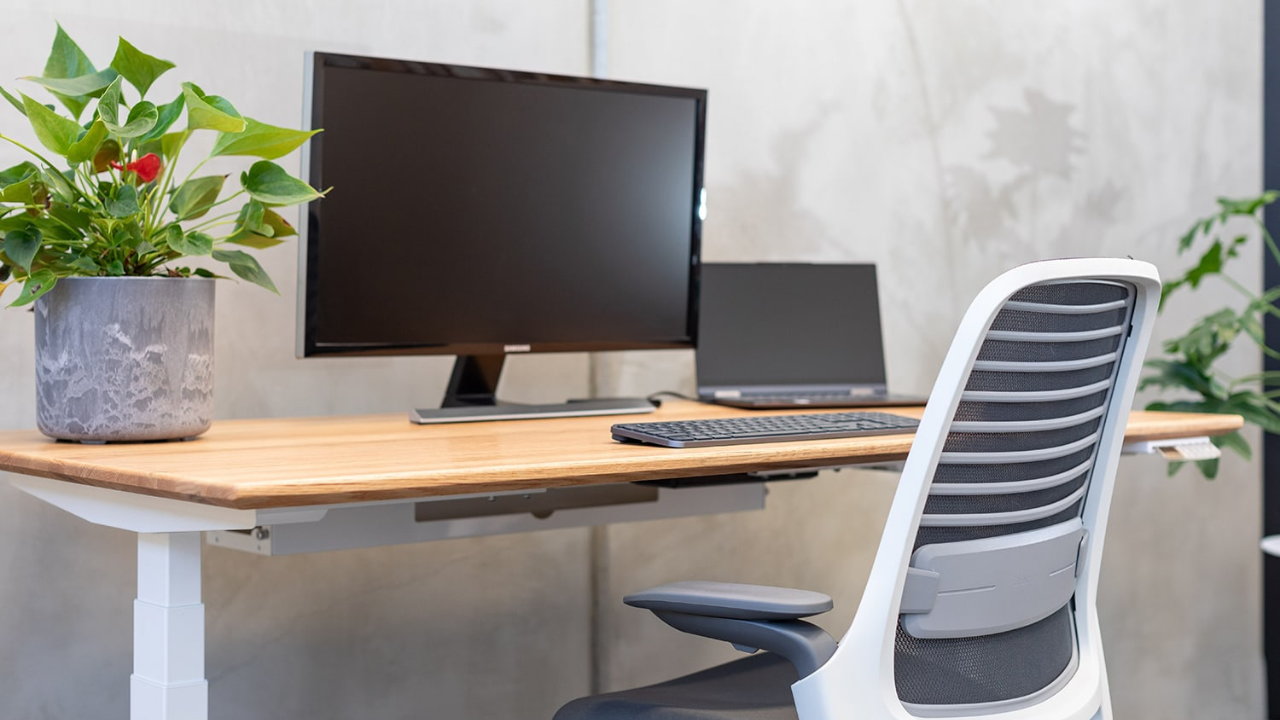There are many advantages to alternating between standing and sitting at a desk. But you can have too much of a fine thing. Standing desks have become increasingly popular in home offices and workplaces, changing the working experience for thousands of people. Although using a standing desk seems to have obvious benefits, many people are confused about how long you should stand at a standing desk.
So, how long should you stand at a standing desk? It is best to stand at the desk for 30-60 minutes every time. You ought to spend about one hour standing for each hour or two you use sitting. Although this can seem like too much switching between sitting and standing, this seems to be the finest balance for enjoying sitting and standing health benefits. This article helps to review the issues with sitting for very long and offer some best practices for working with standing desks to help you choose how long to sit and stand every day.
Is it better to stand or sit at work?
Sitting very long increases the risk of developing chronic health conditions. Too much sitting and lying may cause diabetes, abnormal cholesterol levels, high blood pressure, heart disease, and certain cancers. Most full-time workers spend eight hours sitting at their desk, then come home to sit down on the couch the entire night before going to bed for extra eight hours to rest. This all adds to the sedentary health and lifestyle issues.
Some studies have found that those who usually sit for eight hours per day at work have a similar risk of dying because of obesity and smoking. Research using data from one million people found that it would take about 60 to 75 minutes of reasonably intense physical movement to counteract the effect of sitting very long.
Many workplaces have brought standing desks to not sit on an office chair all day to combat this problem. Standing at work increases calories burned, leading to more energy and weight loss. Standing desks are also proven to reduce stress, increase productivity, and improve mood.

How many hours should you stand a day?
Everyone is different, so the exact right ratio of sitting to standing will be different for each person. Although research is ongoing most ergonomic experts recommend standing roughly 5-15 minutes out of every hour when using a standing desk.
A study in the British Journal of Sports Medicine recommended moving, standing, and taking breaks from sitting for a total of at least 2 hours in an 8-hour work day; building up to standing and moving for half of an 8-hour day may increase the benefits.
That time includes other movement during the day as well – trips to make coffee or to get lunch, a walk around the park, office or house, a brief stretching break. All that counts, too, and is better, but a standing desk makes it easier to meet your overall goal.
How often should you stand with a standing desk?
Frequent changes in position provide the most benefit, and experts recommend alternating between sitting and standing every 30 minutes or so.
Risks of standing for too long
It is proven that standing all day isn't good and has personal health risks. Regardless of the proven advantages of standing desks, it appears that you can also stand for too long a period. If you ask anyone who stands all day, the majority will say it is not easy. Standing too long can cause backache and troubles with varicose veins, leg muscles, and tendons.
In 2017, the Ergonomics journal wrote a study that found that standing for long causes discomfort and may even decrease the reaction time. Some participants gave a small sample that reported deterioration in their mental state after standing for two hours. While standing appeared to assist with creative problem-solving, participants reported leg swelling and muscle fatigue.
If you're tired or have pain because of standing, an anti-fatigue mat will assist. The mat encourages small and regular leg movements to reduce discomfort and improve blood circulation. Several mats are intended for muscle stimulation, whereas others are spongy for comfort. Whatever mat type you select, the material encourages you to move around frequently during the day.
Essentially, a good anti-fatigue mat may allow you to move naturally and give you the option to put your feet in various positions, which helps you burn more calories and change your position to find relaxed positions.
How to use a standing desk correctly
If you have a standing desk, the proper use of alternating sitting and standing all day is one thing. Choosing a high-quality desk that allows you to stand easily is the priority, but hours can quickly go by without alternating between standing or sitting. It can be unpleasant to sit all day waking up to the alarm clock, but you may not have to stick to your schedule if you're not standing in one way or another. Here are some tips on how to use your standing desk correctly.
1. Use a fun and quiet timer
Rather than setting the jarring alarm on the computer or phone, use a fun timer to calculate half an hour or 60 minutes. It will not distract you and others if you are in a meeting; however, you'll notice it, and you can adjust and stretch.
2. Walk when you transition
Taking 5 minutes of walking every hour can significantly improve your focus and mood and ease your afternoon cravings in your workday. Having a quick walk while transitioning from sitting to standing or standing to sitting is the best way to correct your posture, clear your mind, and prepare for the next work session.

3. Check the posture
Whether sitting or standing at your desk, it's very significant to be constantly alert of your posture. When sitting or standing, you can hunch against the computer screen. Hunching can put a lot of pressure on your shoulders and neck, causing headaches and pain throughout the day. Check the posture constantly, not just when changing positions. Changing your posture can be an excellent reminder to verify your posture, but you should not relax at the end of each hour.
4. Use a comfortable mat
Invest in ergonomic accessories and use ergonomic mats with a standing desk. These mats help ease tension in your legs and throughout the backbone, allowing you to stand for long and be more upright without feeling uncomfortable.

Advantages of Standing desks
Increase productivity
The significant advantage of standing desks is that they can improve your overall morale and performance. Small changes in mood in daily meetings may foster a better culture in the office and encourage camaraderie among co-workers.
Reduce lower back pain
Studies show that around 80% of working adults experience neck and back pain not less than one time in their lives when sitting for an extended period. Because back pain is common among office workers, many people need a standing desk because it helps to reduce lower back pain.
Help to lose weight
Weight gain is frequently caused by overeating or an unhealthy diet. But another way that causes overweight or obesity is a sedentary lifestyle. This lifestyle does not mean staying at home. It can also mean spending much time at work while sitting and not exercising to compensate for immobility.
Avert metabolic syndrome
Sitting for many hours results in irreparable damage to the well-being. One reason is that prolonged sitting is associated with a slow metabolism. The more you sit instead of standing, the excess fat accumulates in your brain, heart, and liver.
Metabolic syndrome is the common name for all diseases that increase the risk of obesity, diabetes, stroke, and heart disease. The benefits of standing desks include burning calories and activating the body's blood sugar, triglycerides, and cholesterol.
Reduces cancer risk
Some types of cancer are associated with a sedentary lifestyle and prolonged sitting. This includes breast and colon cancer, which are potentially fatal diseases. While there isn't a direct causal relationship between cancer prevention and standing more, we know that a healthy and active lifestyle contributes to better overall health. There is nothing wrong with developing a healthier way to stand more often, particularly if genetics predispose you to cancer.
Lowers the heart disease risk
Sitting for long increases the risk of cardiovascular disease. This includes myocardial infarction, congestive heart failure, and coronary artery disease. Muscle failure leads to the suppression of an enzyme known as lipoprotein lipase. Typically, this enzyme is responsible for converting awful cholesterol into better cholesterol. Therefore, a sedentary lifestyle exposes them to high cholesterol and heart-related problems. Hence working on a standing desk lowers the heart disease risk.
Lower blood sugar level
We are most likely all too familiar with the steps to prevent diabetes. This includes limiting sugar intake, maintaining a healthy weight, not smoking tobacco, and exercising regularly. Health professionals have added something else to the list: to evade sitting for long.
Standing up for 20 to 30 minutes breaks the period of inactivity to help prevent type 2 diabetes. Since the energy of sitting is very low, the occasional standing will assist the body in processing blood sugar so it doesn't rise.
Prevents neck fatigue
Long office sessions often require bending your neck to the computer. This position creates a "C" shaped position that can strain the neck. The pain may be mild at first but can become persistent and possibly increase discomfort over time. A standing desk in the workplace can be very supportive in minimizing this, as standing straightens the spine and prevents neck fatigue.
Conclusion
Whether staying in a tiny studio or working in a large office, adding the standing desk is excellent to make a big difference. It's a significant investment in your current health as well as your future well-being. Stand at the standing desk for 30 to 60 minutes every time.








